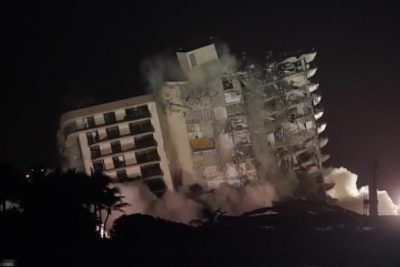Miami officials use explosives to demolish what’s left of collapsed condo tower
Rescuers were given the all-clear to resume work looking for victims at a collapsed South Florida condo building after demolition crews set off a string of explosives that brought down the building’s remains in a plume of dust.
Miami-Dade County’s mayor, Daniella Levine Cava, said the demolition went “exactly as planned” at about 10.30pm on Sunday.
Crews immediately began clearing some of the new debris so rescuers could start making their way into parts of the underground garage that is of particular interest.
Once there, they were hoping to get a clearer picture of voids that may exist in the rubble and could possibly harbour the 121 people believed to be trapped under the fallen wing of the Champlain Towers South in Surfside that collapsed on 24 June.
No one has been rescued alive since the first hours after the collapse. On Sunday, Miami-Dade police identified David Epstein, 58, as one of the 24 people known to have died in the fallen tower. His remains were recovered on Friday.
Shortly after the demolition, cranes were again in motion at the site, suggesting that crews were back in place in the early hours of Monday to sift through the rubble from above and below.
Rescuers are hoping the demolition will give them access for the first time to parts of the garage area. Once a new pathway into the initial rubble is secure, “we will go back to the debris pile, and we’ll begin our search and rescue efforts,” the Miami-Dade fire chief Albert Cominsky said at a press conference several hours before the remaining wing of the residential high rise came down.
During the demolition, loud blasts echoed from the structure. Then the building began to fall, one floor after another, cascading into an explosion of dust. Plumes billowed into the air as crowds watched from afar.
“It was picture perfect. Exactly what we were told would happen,” Levine Cava said after the demolition.
The mayor expressed relief that the search for victims could now continue, after being suspended on Saturday so workers could begin rigging the damaged but still-upright portion of the partly collapsed tower with explosives – a precarious operation that could have caused the structure to fail.
“I feel relief because this building was unstable. The building was hampering our search efforts,” Levine Cava said.
The approach of Tropical Storm Elsa has added urgency to the demolition plans, with forecasts suggesting there could be strong winds in the area by Monday. President Joe Biden declared a state of emergency in Florida because of the storm, making federal aid possible.
The latest forecasts have moved the storm westward, mostly sparing south Florida, but a National Hurricane Center meteorologist, Robert Molleda, said the area could still feel effects. “We’re expecting primarily tropical storm force gusts,” Molleda said, referring to gusts above 40mph.
The decision to demolish the remnants of the Surfside building came after concerns that the damaged structure was at risk of falling, endangering the crews below and preventing them from operating in some areas. Parts of the remaining building shifted on Thursday, prompting a 15-hour suspension in the work.
Authorities had gone door to door to advise nearby residents of the timing of the demolition and to ask them to keep windows closed. They were told to stay inside until two hours after the blast to avoid the dust raised by the implosion.
The method used for Sunday night’s demolition is called “energetic felling”, which uses small detonation devices and relies on the force of gravity.
Levine Cava, speaking before the demolition, said that should bring the building down in place, containing the collapse to the immediate surroundings so as to minimally disturb the existing mound of debris – where many people are believed to be trapped.
Officials used tarps to visually mark the search area, in case new debris scattered unexpectedly.
In implosions – using explosives to have a building fall in on itself – the charges are generally set off in rapid succession over a matter of seconds, said Scott Homrich, who heads the National Demolition Association and runs his own demolition company in Detroit, Michigan. Setting the explosives off at intervals serves to break up the building at the same time as it comes down.
(
Guardian)


